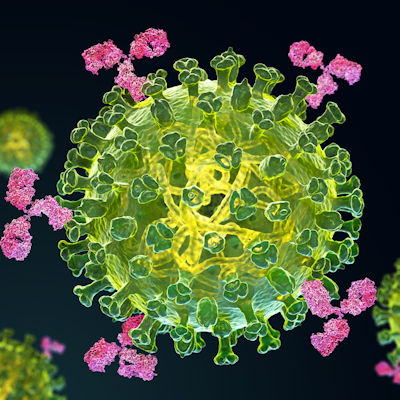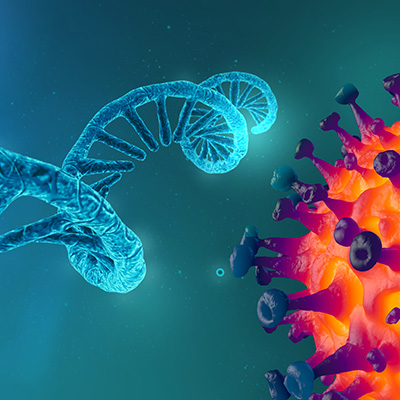January 26, 2021 -- A new study shows that antibodies against the original 2003 SARS-CoV also react with the current SARS-CoV-2 strain, but only with limited effectiveness. The findings were published in Cell Reports on January 25.
Coronaviruses are enveloped, positive-sense, single-stranded RNA viruses with large genomes. Most contain two open reading frames that code for 16 nonstructural proteins and other open reading frames that code four structural proteins -- spike, nucleocapsid, membrane, and envelope -- along with nine accessory proteins.
Because of its high degree of sequence similarity, SARS-CoV-2 was designated as a strain of the same species as the original SARS-CoV. The essential spike proteins of the two viruses share 76% amino acid homology and both depend on cellular angiotensin-converting enzyme 2 (ACE2) as an attachment receptor as well as the TMPRSS2 protease for viral priming.
The viral spike protein produces the most SARS-CoV-2-specific antibody responses against the virus. Recently cross-reactive antibodies that bind the spike protein of both SARS-CoV and SARS-CoV-2 have been identified. Pushing this idea further, antibodies against the SARS-CoV-2 structural proteins could be used as reagents in microscopy and western blotting, as structural tools to probe functional epitopes, and even as antiviral therapies.
Because SARS-CoV and SARS-CoV-2 are similar viruses, researchers from Oregon Health & Science University (OHSU) wanted to know if there is cross-reactivity between SARS-CoV antibodies against other cognate SARS-CoV-2 structural proteins.
The researchers characterized a series of SARS-CoV monoclonal antibodies for cross-reactivity and neutralization of live SARS-CoV-2 virus. The antibodies analyzed targeted three different epitopes in the spike receptor-binding domain (RBD). Antibodies 240C, 341C, and 540C all bind within a region at the end of the RBD, while the 154C antibody binds to a region at the beginning of the RBD. The human monoclonal antibody CR3022 binds to specific residues in a broad region in the middle of the RBD. Alternatively, 472C (rabbit) targets the envelope protein, 19C and 283C target the membrane protein, and 42C targets the nucleocapsid protein.
Cross-reactive antibodies targeting coronavirus structural proteins
They found that the sequence similarity between the SARS-CoV and SARS-CoV-2 nucleocapsid, membrane, and envelope proteins are high, at 91%, 90%, and 95% respectively, suggesting that any individual antibody may be cross-reactive.
To assess SARS-CoV antibodies against SARS-CoV-2, the team performed immunofluorescence staining of Vero E6 cells infected with live SARS-CoV-2 virus. SARS-CoV structural protein antibodies demonstrated good staining, including 240C, NRC-772, and CR3022 against the spike protein; 42C against the nucleocapsid protein; 283C against the membrane protein; and 472C against the envelope protein.
Next, the researchers evaluated the panel of SARS-CoV antibodies by western blot, targeting the RBD of the SARS-CoV-2 spike protein, produced in HEK 293 cells. Of the antibodies, 240C and NRC-772, targeting the spike protein, also gave a clear signal in western blot with minimal background, whereas the other monoclonal antibodies (CR3022, 154C, 341C, and 540C) did not produce a detectable signal.
With enzyme-linked immunosorbent assay (ELISA), the CR3022 and 240C antibodies showed strong binding to both the full-length spike and the RBD, 154C and 341C showed weak but detectable binding, while 540C did not demonstrate binding at all. Using biolayer interferometry, CR3022, 240C, and 154C showed the strongest binding with high affinity for the SARS-CoV-2 RBD.
SARS-CoV-2 neutralization by SARS-CoV antibodies
To test the neutralizing capabilities of the spike protein-specific monoclonal antibodies, the researchers conducted a neutralization assay using a lentivirus green fluorescent protein-reporter pseudotyped with the SARS-CoV-2 spike protein. Here, CR3022 failed to show any neutralization, 341C and 540C did not show substantial neutralization, while 154C and 240C both showed partial neutralization.
The authors noted that some of the neutralizing SARS-CoV structural protein antibodies were not neutralizing against SARS-CoV-2. They suggested that this is because highly neutralizing antibodies often bind to highly variable epitopes in rapidly evolving viruses. In the case of SARS-CoV-2, substitutions in the RBD compared to SARS-CoV were selected for, in part, due to their ability to avoid binding by existing SARS-CoV antibodies.
"Our finding has some important implications concerning immunity toward different strains of coronavirus infections, especially as these viruses continue to mutate," said senior author Fikadu Tafesse, PhD, assistant professor of molecular microbiology and immunology in the OHSU School of Medicine, in a statement.
Despite only partial neutralization of SARS-CoV-2, these antibodies may still be important tools for structure determination and in mapping protein functional regions of the virus and understanding the biology of the virus generally.
"I don't think there is any one-size-fits-all vaccine," said Tafesse. "Although the vaccines coming out now may break the momentum of the virus and end the pandemic, they may not be the end game."
"Emerging mutant viruses may have some propensity to escape certain antibodies raised by previous infection or vaccine," said lead author Timothy Bates, a fourth-year molecular microbiology and immunology graduate student in the OHSU School of Medicine. "Every individual has a different immune system that will make a unique repertoire of different antibodies that bind to different places on the virus, so the chance of any one SARS-CoV-2 variant escaping from all of them is quite low."
Do you have a unique perspective on your research related to infectious diseases and immunology? Contact the editor today to learn more.
Copyright © 2021 scienceboard.net









